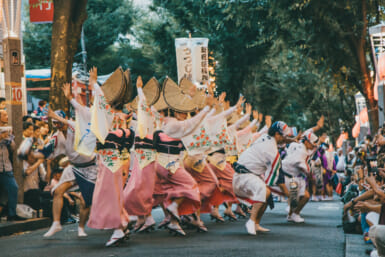by Yurie Horiguchi
After World War II, the male chauvinists who dominate the political and civic life of Japan committed a dastardly deed. They abolished Mar. 3, or Dolls’ Festival Day, as a national holiday and lumped the girls together with the boys on May 5, now designated as Children’s Day.
Now May 5 has been celebrated since the Tokugawa Era as Tangu-no-Sekku, or Boys’ Festival Day, whereas Mar. 3, or Hina Matsuri, has a much, much longer history.
The women and girls of Japan, however, have refused to be daunted by such overt discrimination. As I mentioned in an earlier article, the Japanese woman may be outwardly docile but inside there is almost always a core of steel. This strength makes her the pillar that sustains the home.
The Dolls’ Festival Day therefore continues to be celebrated in homes with daughters throughout the nation, and makers of the special dolls and miniature furniture exhibited on this occasion continue to ply their trade and make a seasonal fortune as prices rise, and rise and rise.
Mukashi mukashi, or once upon a time, sorcerers (our first exorcists) were summoned on the first day of the serpent in March to drive away evil spirits lurking in human breasts. The “first day of the serpent” became Mar. 3 after the solar calender was adopted in Japan. But to get back to our exorcists, they drove the evil spirits out and transferred them to paper dolls which were then floated down a nearby river or stream, wherein they drowned.
As time went by, the talisman dolls were made of more permanent material such as mud or clay, and placed on shelves instead of being floated away, and wine and sweets were offered to them on the day of the serpent. This seems to me to be a big switch as the evil spirits then presumably lived on in the house- unless the wine and food were poisoned, but there is no record of that.
As time continued to march on, and sorcerers disappeared from the general scene, more elaborate dolls came to be made, and in the Imperial Court of Kyoto, children of the nobility played with dolls called hina, dressed in the image of aristocrats of the day.
In the 1700s, with the coming of the Tokugawa Era, the Hina Matsuri was designated as one of the five festivals of Japan, and a national holiday to boost. This raises the Tokugawas in my esteem. No male chauvinists were they. In fact they all adored women and kept as may of them as possible in the height of luxury, if history is to be believed.
But before the Hina Matsuri developed into the elaborate display of dolls, dolls’ furniture etc., it later became, the early dolls were known as dairi-bina, which were a couple representing the highest court personages (either the emperor and empress or the shogun and his spouse), generally made of clay and very richly costumed.
Green mochi (rice cakes) flavored with the juice of a herb called yomogi, a kind of mug-wort (and please don’t ask me what that is), were placed before the dairi-bina, together with shirozake, a mild, thick white sake (the forerunner of the present distilled brew).
In the Edo Era there were, as students of Japanese history know, two courts. The Imperial Court of Kyoto, and the Tokugawa Court of Tokyo (Edo), and because of this, the Kyoto display was set up differently to the Edo Display.
On the top stand of the Kyoto display, the dairi-bina representing the Emperor and Empress were seated under a miniature structure representing the palace, whereas the Edo dairi-bina sat in front of miniature gold screens.
The Kyoto display had the usual ladies in waiting, court attendants and serviteurs, but no musicians. Toy cherry and mandarin trees were included, as well as an ox-drawn court carriage. The Edo version was a toy plum and mandarin tree and a miniature palaquin to replace the imperial carriage.
Other Edo additions were the miniature furniture representing a bride’s dowry (even today many brides are expected to contribute their own furniture when they marry, such as tansu, wardrobe, dressing-table, futon, etc.). As the miniature furniture is extremely elaborate, it represented the type that only wealthy townsfolk, the nobility and the samurai class could afford to contribute, and was (and still is) the envy of the proletariat.
Today, everything has been mixed up together. The very best and most expensive display of festival dolls and furniture is now placed on seven stands (lesser displays have only five stands).
The stand is covered with a red cloth, with the two principal dairi-bina seated at the top, with the male figure always on the right of the female. A pair of andon (traditional oil lamps) are placed at each extremity.
The second tier is occupied by three dolls representing ladies in waiting, or kanjo. Five noh musicians, or gonin-bayashi, are seated on the third tier. The fourth tier is occupied by a set of two attendants, or zuishin, with arrows on their backs and bows in hand. The fifth tier holds three servants, or shicho.
On the sixth and seventh tiers of a first-rate display, are placed the diminutive articles of furniture, the palanquin, etc.
Most of the elaborate hina matsuri sets today are heirlooms, passed down from mother to elder daughter over the generations. Only the wealthy could afford them in the past, and this is still true today as prices become yearly more exhorbitant.
But little girls, no matter what their parents’ social position, don’t like to be done out of their hina matsuri dolls, and there are inexpensive sets to suit all purses, although the best way of accumulating a good set is for parents and relatives to start the ball rolling by presenting a set of two, three or five dolls to a baby girl on her first Mar. 3 celebration. In this way, the set can be built up over the years until all the necessary pieces are obtained, becoming a thing of beauty and a joy forever, as someone else once said.








